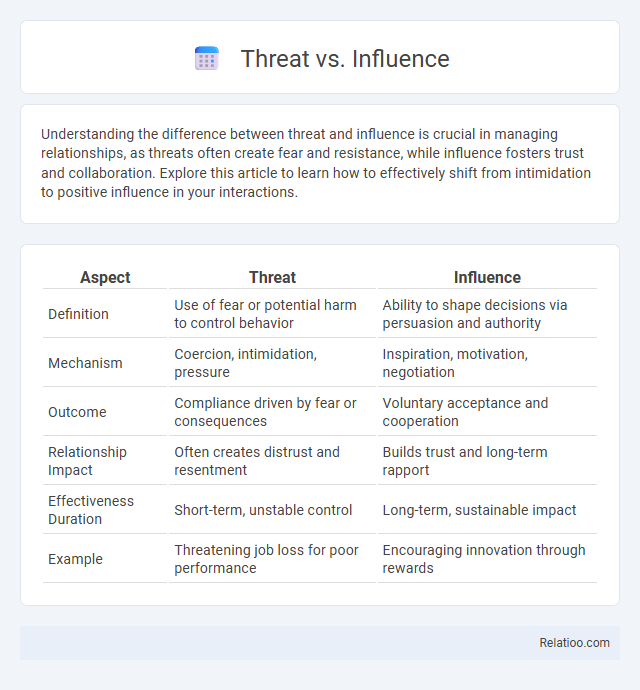Understanding the difference between threat and influence is crucial in managing relationships, as threats often create fear and resistance, while influence fosters trust and collaboration. Explore this article to learn how to effectively shift from intimidation to positive influence in your interactions.
Table of Comparison
| Aspect | Threat | Influence |
|---|---|---|
| Definition | Use of fear or potential harm to control behavior | Ability to shape decisions via persuasion and authority |
| Mechanism | Coercion, intimidation, pressure | Inspiration, motivation, negotiation |
| Outcome | Compliance driven by fear or consequences | Voluntary acceptance and cooperation |
| Relationship Impact | Often creates distrust and resentment | Builds trust and long-term rapport |
| Effectiveness Duration | Short-term, unstable control | Long-term, sustainable impact |
| Example | Threatening job loss for poor performance | Encouraging innovation through rewards |
Understanding Threat vs Influence
Understanding the difference between threat and influence hinges on the intent and method of persuasion; a threat relies on fear of negative consequences to coerce behavior, while influence uses persuasion and appeal to values or interests to shape decisions. Threats often involve explicit or implicit promises of harm or punishment, creating pressure through potential loss or danger. Influence, in contrast, builds trust and appeals to rational or emotional factors, fostering voluntary compliance without coercion.
Key Differences Between Threat and Influence
Threat involves coercion or the promise of harm to force behavior, relying on fear and potential negative consequences, while influence shapes decisions through persuasion, trust, and positive reinforcement without overt pressure. Influence leverages credibility and relationships to encourage voluntary compliance, whereas threat depends on authority and the possibility of punishment to demand obedience. Understanding these distinctions clarifies how power dynamics operate in social, political, and organizational contexts.
Psychological Foundations of Influence
Threats, influence, and intimidation each operate through distinct psychological mechanisms influencing human behavior and decision-making. Influence leverages trust, reciprocity, and social proof to guide actions, engaging cognitive processes and emotional responses in a non-coercive manner. In contrast, threats and intimidation rely on fear and perceived negative consequences, activating stress responses that may impair rational decision-making and heighten compliance through avoidance of harm.
Recognizing Threats in Communication
Recognizing threats in communication requires understanding subtle cues such as tone, word choice, and context that signal potential harm or coercion. You can differentiate threats from influence and intimidation by identifying direct or implied promises of negative consequences aimed at controlling behavior. Awareness of these distinctions enhances your ability to respond effectively and protect your personal and professional boundaries.
The Role of Power in Threat and Influence
Power dynamics play a critical role in distinguishing threat, influence, and intimidation, with threat leveraging the potential for harm to compel behavior, while influence relies on authority or persuasion to shape decisions. Threats often involve coercive power that imposes consequences to enforce compliance, contrasting with influence which utilizes legitimate, expert, or referent power to motivate voluntary acceptance. Intimidation combines elements of both but emphasizes fear and dominance, underscoring power as a tool for control through psychological pressure.
Ethical Implications of Threatening vs Influencing
Threatening others raises significant ethical concerns due to its coercive nature, potentially causing fear, harm, and manipulation that undermine personal autonomy and trust. Influence, when exercised ethically, respects individual consent and encourages positive decision-making without resorting to fear or force. Your approach to communication should prioritize ethical influence over threats to foster respectful and constructive interactions.
Impact on Decision-Making: Threats vs Influence
Threats often trigger fear and stress, impairing your ability to make rational, well-informed decisions by focusing attention on immediate danger rather than long-term outcomes. Influence leverages persuasion and credibility, encouraging thoughtful consideration and voluntary compliance, which leads to more sustainable and positive decision-making. The contrasting impacts highlight how threat-driven decisions may be reactive and short-sighted, while influence fosters proactive and deliberate choices.
Real-World Examples: Threat versus Influence
Threat involves coercing or pressuring someone through fear of harm, such as a company threatening legal action to suppress competition. Influence operates by subtly shaping decisions and behaviors without force, seen in celebrity endorsements swaying consumer choices or political campaigns guiding public opinion. Your ability to distinguish between threat and influence can help you navigate social and professional interactions more effectively, recognizing when power is used overtly versus persuasively.
Strategies to Respond to Threats and Influence
Effective strategies to respond to threats involve clear communication, setting firm boundaries, and employing assertiveness to de-escalate tension. Influence requires understanding psychological tactics such as persuasion and social proof, enabling individuals to reinforce desired behaviors and resist manipulation. Combining emotional intelligence with strategic dialogue enhances the ability to distinguish between intimidation, which often relies on fear, and genuine influence aimed at cooperation.
Building Positive Influence Over Resorting to Threats
Building positive influence relies on respect, trust, and genuine communication, which foster lasting relationships and cooperation. Threats often create fear and resistance, undermining your authority and damaging team morale. Choosing constructive influence over intimidation empowers you to motivate others effectively and achieve sustainable success.

Infographic: Threat vs Influence
 relatioo.com
relatioo.com